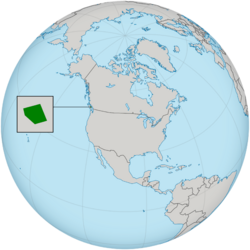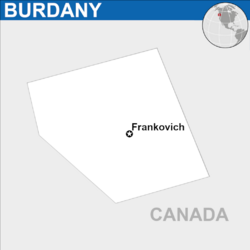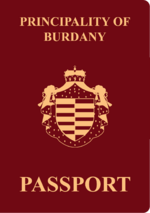Principality of Burdany
This article refers to a micronation or element of micronationalism which is defunct and no longer exists. You can help make the article reflect that or ask on the talk page for further information. |
Principality of Burdany | |
|---|---|
| Motto: "Gott, mein Vaterland und mein Schwert" "God, my Fatherland and my Sword" | |
| Anthem: "Hail to thee, Burdany" | |
 Location of Burdany (green) in North America (agate grey) | |
 | |
| Status | Active |
| Capital | Frankovich |
| Official languages | English (de facto) |
| Recognised national languages | German |
| Ethnic groups (2023) |
|
| Religion (2023) |
|
| Demonym(s) | Burdanian |
| Government | Unitary parliamentary semi-constitutional monarchy |
• Monarch | Karl I |
• Prime Minister | Marcus Salsibury |
| Legislature | Zentraldiät |
| Independence from Canada | |
• Establishment | 19 May 2023 |
| 2 October 2023 | |
• Government dissolved | 4 December 2023 |
| Area | |
• Total | 0.00161874 km2 (0.00062500 sq mi) |
| Population | |
• 2023 census | 8 |
| HDI | 0.936 very high |
| Currency | Burdanian Mark (ℳ︁) (BDM) |
| Time zone | UTC−8 (PST) |
• Summer (DST) | UTC−7 (PDT) |
| Date format | mm/dd/yyyy |
| Driving side | right |
| Calling code | +1 |
| Internet TLD | .bu (proposed) |
Website example | |
Burdany, officially the Principality of Burdany, was a landlocked micronation that claimed approximately 0.40 acres of territory on Vancouver Island in the Canadian province of British Columbia. Burdany declared its independence from Canada in 2023, but its existence is not formally recognized by the government of any sovereign state.
Burdany was a principality governed under a semi-constitutional monarchy headed by the Prince of Burdany. The prince was a hereditary sovereign who reigned as the nation's head of state, while an elected prime minister served as head of government. The political structure of Burdany was largely modeled on that of Liechtenstein, and had a culture deeply inspired by German and Canadian history.
Etymology
The name Burdany traces its origins to Burdany Castle, the palace and official residence of the Princely Family. The residence itself was originally named after Burdyny, the surrounding region where the principality was located, but with a slightly altered spelling. Residents of Burdany used the demonym Burdanian.
History

The Principality of Burdany was founded on 19 May 2023 by Canadian micronationalist Karl Salisbury. Taking inspiration from other self-declared micronations such as Molossia and Sealand, Salisbury felt compelled to also create a country of his own. Believing that a principality was the best model of government for a small nation, Salisbury declared his 0.40 acre property to be his own sovereign realm and adopted the noble title of prince. Choosing his first name, Karl, as a regnal name, the newly crowned prince began his reign by establishing the Princely House of Burdany to rule over the territory alongside his family.
By late 2023, Burdany had created its very own flag, coat of arms and national anthem. In October 2023, the Bank of Burdany was established to produce and circulate the official currency of the principality, the Burdanian Mark. In December 2023, the Treaty of Frankovich was signed between the governments of Burdany and Permaria, which resulted in Burdany's government being dissolved and its territorial claims being absorbed into the more established principality.
Politics and government
Burdany was a unitary, semi-constitutional monarchy with a prince as its monarch and head of state. Its political system combined elements of absolute monarchy with representative democracy and direct democracy. The political structure of Burdany was unique for the fact that the Burdanian government formally acknowledged the suzerainty of King Charles III in his right as King of Canada, while simultaneously maintaining complete autonomy over its internal affairs and foreign policy.
Prince

Prince Karl I was the country's sovereign and head of the ruling House of Burdany. The Constitution of Burdany described the prince as the symbol of the Burdanian state and the physical embodiment of the unity of its people. Burdany's semi-constitutional monarchy was based on the Prusso-German model, in which the prince was an active ruler and wielded considerable political power over domestic and foreign policy. Under Burdanian law, the prince ruled by divine right and shared executive power with the legislature on behalf of the state and his subjects. The prince had veto power, the authority to appoint and dismiss government ministers and judges, as well as the ability to call or dismiss referendums. The prince was immune from prosecution by the Supreme Court of Burdany. Eligibility to inherit the throne was hereditary and limited to members of the ruling Princely House. The monarchy of Burdany practiced male-preference primogeniture, with females only inheriting the throne in the absence of a suitable male heir.
Prime Minister

The Prime Minister of Burdany was head of government as well as a close advisor to the prince. The post of prime minister was an elected position, and its office could be occupied by both commoners and nobility alike. The prime minister headed the the country's legislative branch and formally signed all proposed bills into law upon the advice of his/her ministers. Prime ministers were elected by direct majority vote and formally appointed to the post by the prince for a renewable 4 year term. Burdany's last prime minister was Marcus Salisbury, a cousin of the reigning prince.
Legislature
The Central Diet, or Zentraldiät, was the unicameral legislature of the principality, and its highest deliberative body. The Zentraldiät had five members who are directly elected to a renewable four-year term by universal suffrage. Candidacy was open to all Burdanian citizens aged 18 or older. The primary purpose of the Zentraldiät was to pass legislation, and present it to the prime minister for final consideration. Successful bills were then granted Princely assent before being formally signed into law.
Political parties
Burdany had a two-party system where two political parties, the Christian Democratic Party and the United Patriots of Burdany, dominated politics within the legislature due to the country's small size. The largest of the two parties, the Christian Democrats, maintained a slim majority in the Zentraldiät while the nation's oldest party, the United Patriots, formed the official opposition.
| Logo | Name | Spectrum | Ideologies | Seats | ||
|---|---|---|---|---|---|---|
| Christian Democratic Party | CDP | Centre to centre-right | Liberal conservatism Economic liberalism Constitutional monarchism Christian democracy |
3 / 5
| ||
| United Patriots of Burdany | UPB | Centre-right to right-wing | Conservatism Nationalism Economic liberalism Constitutional monarchism Christian democracy Anti-communism |
2 / 5
| ||
Law and order
Article III of Burdany's Constitution guaranteed equal rights to all citizens. All citizens residing in Burdany or Canada were considered dual-citizens and thus, had the same legal rights and responsibilities that they enjoyed in Canada. Article VI required every Burdanian to obey Canadian federal and provincial laws at all times. The same rule applied to its citizens living abroad with regards to the laws of their home countries. The Supreme Court of Burdany handled internal disputes within the principality, and any citizen who believed that his or her fundamental rights and freedoms have been violated was entitled to apply to the court for relief, or complain directly to the prince or prime minister.
Military
Burdany did not possess a military of any kind, and instead sought to preserve its sovereignty through membership in diplomatic organizations. The country relied on the Royal Canadian Mounted Police to deal with criminal activity that poses a threat its citizens or state property, while the Canadian Armed Forces defended its surrounding Canadian territory in the event of an attack from a hostile foreign power. Burdany maintained a small police force, the Burdanian National Police (BNP), which was on hand to respond to any small internal problems within the principality. The BNP was comprised of a sheriff and two deputies.
Ministries
The principality had nine active ministries within its government:
- Ministry of the Princely Household
- Ministry of State
- Ministry of Foreign Relations
- Ministry of the Interior
- Ministry of the Treasury
- Ministry of Justice
- Ministry of Health
- Ministry of the Environment
- Ministry of Development
Foreign relations
The Principality of Burdany never received diplomatic recognition from the government of any internationally recognized sovereign state, but it established diplomatic relations with several other micronations and independence movements. Burdany cited the declarative theory of statehood, famously expressed in the 1933 Montevideo Convention, as legal justification for statehood since it met the criteria to be considered a sovereign nation.
Burdany appointed several diplomatic agents abroad to press its rights for self-determination. Its government formally recognized the sovereignty of over 200 nations worldwide.

Unilateral recognition
 All United Nations member states
All United Nations member states British West Florida
British West Florida Bumbunga
Bumbunga Cook Islands
Cook Islands Holy See
Holy See Manchukuo
Manchukuo Molossia
Molossia Niue
Niue Palestine
Palestine Sealand
Sealand Slowjamastan
Slowjamastan Somaliland
Somaliland Taiwan
Taiwan Westarctica
Westarctica
Mutual recognition
Geography and climate

Burdany was a landlocked country located entirely within Canadian sovereign territory. It was situated on the eastern coast of central Vancouver Island near the Canadian town of Comox, bordered by forests on two sides and residential housing on the remaining two. Burdany's geography was primarily rural, featuring large flower gardens, ponds, and numerous vegetable crops. Large Douglas fir trees provided shade to the northern portion of the country, which housed a gazebo for hosting diplomatic summits. Frankovich, the nation's capital, was located along the nation's eastern boundary and included street access via Burdyny's main border crossing with Canada. Frankovich was also home to the Burdanian Princely Family, who maintained a residence there year-round.
Burdany has a Mediterranean climate according to the Köppen climate classification. Summers are hot and dry, with frequent heat and wildfire warnings, while winters are typically mild, but can experience heavy rain and snowfall.
| Climate data for Frankovich | |||||||||||||
|---|---|---|---|---|---|---|---|---|---|---|---|---|---|
| Month | Jan | Feb | Mar | Apr | May | Jun | Jul | Aug | Sep | Oct | Nov | Dec | Year |
| Average high °C (°F) | 6.4 (43.5) |
7.4 (45.3) |
9.6 (49.3) |
12.9 (55.2) |
16.6 (61.9) |
19.8 (67.6) |
22.8 (73) |
22.7 (72.9) |
19.0 (66.2) |
12.9 (55.2) |
8.5 (47.3) |
5.9 (42.6) |
13.7 (56.7) |
| Average low °C (°F) | 1.4 (34.5) |
1.2 (34.2) |
2.5 (36.5) |
4.6 (40.3) |
8.0 (46.4) |
11.1 (52) |
13.3 (55.9) |
13 (55) |
9.9 (49.8) |
6.0 (42.8) |
2.9 (37.2) |
0.9 (33.6) |
6.2 (43.2) |
| Source: www.climate.weatheroffice.gc.ca (archived data from 1981–2010) | |||||||||||||
Economy
Burdany had a primarily agrarian economy with a heavy reliance on agriculture for the exportation of eggs, fruits and vegetables to Canada and the United States, as well as localized trade within the country itself. A small aquaculture industry was also present, which consisted of oyster and mussel farming outside the boundaries of the principality. Burdany was almost entirely reliant on Canadian imports for all of its essential goods and services, with the Canadian dollar being accepted for all transactions.
The Burdanian Mark (ℳ︁) was the nation's official currency and was printed and circulated by the Bank of Burdany. The mark was not backed by hard assets, but simply by a promise to pay the bearer upon the the prospect of recognition of the Principality of Burdany as an independent state by the United Nations General Assembly.
Culture
Due to its small size and close proximity to its much-larger neighbors, Canada and the United States, Burdany was strongly affected by external cultural influences. European history, particularly that of Liechtenstein and historical German-speaking states such as the Kingdom of Hanover and Kingdom of Prussia, also played a large role in shaping Burdany's national identity. The various cultures of the British Empire and its many colonial possessions also influenced many aspects of Burdanian society. The principality was rich in European traditions, with a vibrant culture of music, dance, art and literature. National holidays were typically celebrated with feasts, music and dancing. Significant state resources were dedicated to the promoting the works of Burdanian painters, bards, scribes and poets. Traditional American, Canadian, and German cuisine were all widely enjoyed, with a diverse variety of dishes being popular. Chili con carne was the national dish of Burdany and a personal favorite of the prince. The princely family participated in an annual chili cook-off in the capital city of Frankovich, as well as an Irish stew contest. Roman Catholicism was the most widely practiced religion in the country and is its unofficial state religion, although freedom of religion was guaranteed by Burdany's Constitution. A significant number of Burdanians were also adherents of several Protestant faiths, as well as a minority of practicing Hindus and Muslims.
National colors and symbols

The national flag of Burdany was the principle symbol of the country and its people. It was a horizontal bicolour consisting of red and yellow. The colors symbolized the Western sun (red) setting over the sandy beaches of Vancouver Island (yellow). Due to the flag's similarity to the flags of Burgenland, Austria and Pretoria, South Africa, the state flag defaced with the arms of the House of Burdany was sometimes used to represent the nation or its government abroad.
The personal standard of Prince Karl I consisted a white field surrounded by a yellow and red border. The field was defaced with the arms of the House of Burdany topped with the Princely hat. It was used only in the immediate presence of the prince, particularly on cars in which he traveled.
The coat of arms of Burdany was the personal coat of arms of the ruling Prince of Burdany, currently Karl I. As a sovereign emblem of the prince, its use was restricted to the prince, members of his household, and the Government of Burdany for diplomatic purposes. It consisted of the escutcheon of the Princely House. The escutcheon was surrounded by a red (gules) mantle with ermine lining, along with gold fringes and tassels. At the top was placed the Princely hat. There was also a "lesser" coat of arms that consisted of just the escutcheon ensigned by the Princely hat.
-
National Flag
-
State Flag
-
Princely Standard
-
Lesser Coat of Arms
-
Greater Coat of Arms
Holidays
| Date | Name | Remarks |
|---|---|---|
| 1 January | New Year's Day | Celebrates the start of the new year. |
| Third Monday in February | Family Day | Shared statutory holiday with British Columbia. |
| Between 20 March and 23 April | Good Friday | Commemorates the crucifixion of Jesus, on the Friday before Easter. |
| 19 May | Burdany Day | Celebrates the 2023 proclamation of Burdany's independence from Canada. |
| 22 October | Prince's Official Birthday | Celebrates of the birth of Karl I, founding father and reigning prince of Burdany. |
| 11 November | Remembrance Day | Memorial holiday shared with Canada. Honors Canada's war dead. Anniversary of the armistice ending World War I in 1918. |
| 25 December | Christmas Day | Commemoration of the birth of Jesus of Nazareth. |






